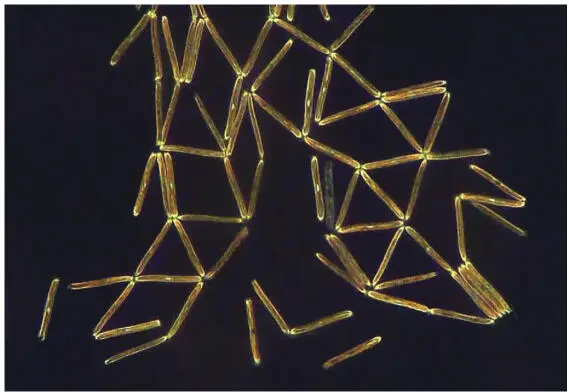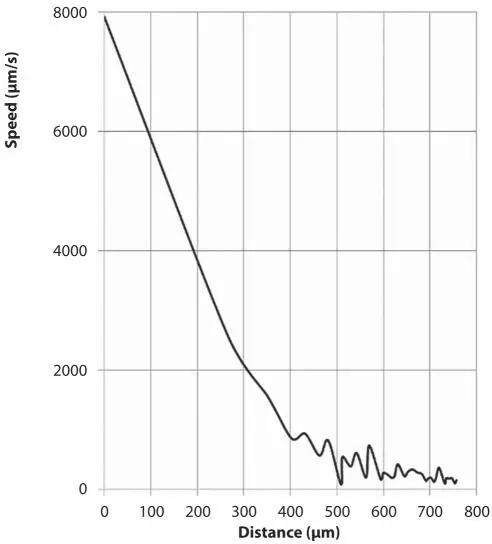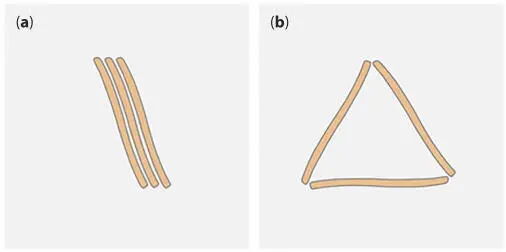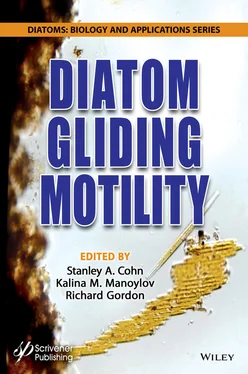
Figure 1.25 Sketch of two adjacent Nitzschia sigmoidea on the water surface seen from the horizontal direction.

Figure 1.26 Very regular structure of a diatom cluster on the water surface (dark field).
A remarkable aspect is the dynamics of movement. Different forms of movement occur, which indicate different mechanisms. Single floating diatoms are able to move slowly in the direction of the apical axis. This is similar to the movement on substrate, but hardly any longer distances are covered. Adhering lumps of EPS are typically not visible. Since no axenic cultures are used, bacteria can usually be seen on the water surface in phase contrast, making water movement observable. One recognizes changing currents of the water along the raphes, which run opposite to the movement of the diatoms. Apparently, the activity of the raphes can couple to a liquid medium. I do not want to exclude the possibility that the bacteria have an influence on the movement by mechanically coupling to the raphes, but in view of their small size and their lack of mutual contact, I consider their influence to be small. Theories of motility that require adhesion to a solid substrate cannot adequately explain this phenomenon. The movement of diatoms in hanging drops at the interface to air was interpreted by Nultsch in 1957 on the basis of the since disproved cytoplasmic streaming theory. Wavelike movements of microfibrils, as suggested by Bertrand [1.4] in 2008 (translation in Chapter 12 of this book), could cause the observed water transport along the raphe. They strengthen this hypothesis. I could not observe this form of movement with certainty in clusters of several connected diatoms, possibly because they contribute little to movement compared to the other forces acting there.

Figure 1.27 Relative speed of two diatoms plotted versus their distance.
It is obvious in Nitzschia sigmoidea cultures with high population density that the diatoms secrete EPS. These excretions can accumulate and lead to the formation of flakes of living diatoms. Sometimes it can be noticed that more or less large lumps of EPS adhere to individual diatoms on the water surface. When two diatoms come into contact through the mediation of an EPS lump, the transport of this lump along the raphes of both diatoms leads to a fast and remarkable movement. As there is no adhesion to a solid substrate, the two diatoms “dance” around each other. This movement pattern often occurs without the EPS lumps being recognizable.
Diatoms that have come together in structures such as those shown in Figure 1.22and Figure 1.26show a peculiar dynamic. The attractive interaction of the hydrophobic apices is of great importance here. If only this attractive interaction existed, a pattern would be formed on the water surface, whereby the movement would come to rest as soon as a local minimum of energy is reached. However, the activity along the raphe and in the area of the apical pore field leads to continuous changes of the pattern. According to the simple model of two hydrophobic particles in the distance of the apices one expects structures with few unbound ends. For example, when there are three diatoms in a cluster, energetically favorable configurations in which all ends have bonds to other diatoms should prevail ( Figure 1.28). A chain of three diatoms should close to a triangle because of the attractive interaction of the free ends. But the diatoms are not passive floating objects, but show active movement. They release energy and thus temporarily produce patterns with higher energy. There are elementary processes which are observable locally in the entire structure pattern. The end of one or more parallel diatoms can be moved by another diatom along its raphe ( Figure 1.29). At the beginning of this movement, an existing connection at an apex of the moved diatom can be broken. Energy is released locally from the diatom into the structure. Angular changes at connected apices ( Figure 1.29b) are very frequent. Diatoms that adhere with the apex on a substrate are capable of performing tilting movements. Probably it is the same mechanism as observed on the water surface. It is by no means certain that all motion sequences can be explained thereby, because the simultaneously occurring changes in this many-body system are very complex. One striking feature is the separation of connections at the apex without subsequent transport along a raphe. It could be due to opposing forces within the cluster. The static attractive force of the apices, the active movement along the raphe, the active change of the angle between two connected diatoms and possibly other mechanisms can generate a very large number of patterns and sequences in a system of several diatoms ( Figure 1.30). These processes are fundamentally different from those on a solid substrate.
In nature, the currents in the water are also likely to whirl up diatoms that do not have a high adhesion to the ground. They may occasionally reach the water surface. The ability to stay there for a longer period of time could lead to dispersal by drifting, i.e., hydrochory.

Figure 1.28 Energetically favorable patterns of three diatoms on the water surface: all diatoms parallel (a) and diatoms form a triangle (b).

Figure 1.29 Frequently observed movement patterns: movement along the raphe (a) and angular changes at connected apices (b).

Figure 1.30 Image sequence showing the temporal development of seven connected diatoms. The time between the first and last image is 170 seconds.

Figure 1.31 Pinnularia gentilis .
I am not convinced of this mechanism and without evidence it is nothing but speculation. A benefit from the mobility at the surface is not evident. Structures of interconnected Nitzschia sigmoidea , as described above, require a very calm water surface in addition to a high population density. Under light winds and waves, these fragile structures will certainly not be able to form or preserve themselves. I consider these patterns and their dynamics to be an artifact that only occurs in cultures, but it allows an insight into the motility of this species.
The observations of Craticula cuspidata , Cymbella spp., Rhopalodia spp. and Pinnularia spp. on the water surface differ in several aspects from those of Nitzschia sigmoidea . In the following I will restrict myself to comments on Pinnularia gentilis ( Figure 1.31) from a small pond in Stuttgart-Hohenheim. At the time of observation, the diatoms were already six months in culture and had a typical length of 200 μm. When Pinnularia cultures are prepared, a fast sedimentation of inserted diatoms is usually observed. In the case of diatoms from these cultures, it is noticeable that many diatoms are stirred up when the Petri dish is carried to the microscope and settle relatively slowly on the substrate. Immediately after swirling up the diatoms, one regularly finds a few to several tens of diatoms on the water surface. Already in the first minutes many of the diatoms sink to the ground. Others remain on the surface for hours and only a few for days. In all observed cases, the sinking starts with the diatom taking a position perpendicular to the water surface. Often it remains on the water surface in this orientation for a while. Either the diatom drops to the ground in this orientation or it rotates around the transapical axis or pervalvarous axis as it sinks. It was not possible to recognize which axis it is. During one observation, a diatom returned from the vertical position back to the horizontal position on the surface, which requires an energy supply by the diatom.
Читать дальше



















